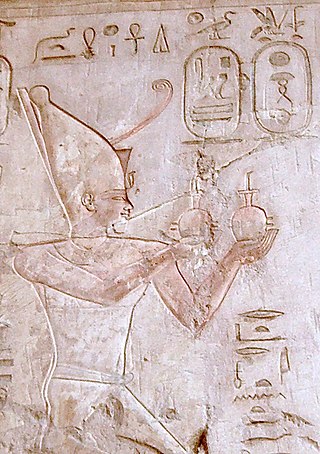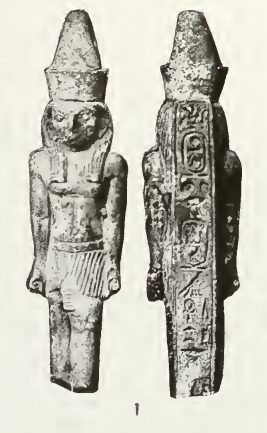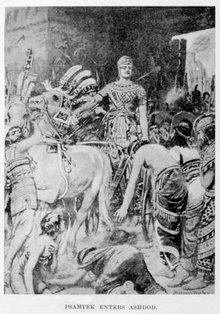
The year 656 BC was a year of the pre-Julian Roman calendar. In the Roman Empire, it was known as year 98 Ab urbe condita. The denomination 656 BC for this year has been used since the early medieval period, when the Anno Domini calendar era became the prevalent method in Europe for naming years.

Necho II of Egypt was a king of the 26th Dynasty, which ruled from Sais. Necho undertook a number of construction projects across his kingdom. In his reign, according to the Greek historian Herodotus, Necho II sent out an expedition of Phoenicians, which in three years sailed from the Red Sea around Africa to the Strait of Gibraltar and back to Egypt. His son, Psammetichus II, upon succession may have removed Necho's name from monuments.

Taharqa, also spelled Taharka or Taharqo, was a pharaoh of the Twenty-fifth Dynasty of Egypt and qore (king) of the Kingdom of Kush from 690 to 664 BC. He was one of the "Black Pharaohs" who ruled over Egypt for nearly a century.

Wahibre Psamtik I was the first pharaoh of the Twenty-sixth Dynasty of Egypt, the Saite period, ruling from the city of Sais in the Nile delta between 664–610 BC. He was installed by Ashurbanipal of the Neo-Assyrian Empire, against the Kushite rulers of the Twenty-fifth Dynasty, but later gained more autonomy as the Assyrian Empire declined.

Psamtik II, known by the Graeco-Romans as Psammetichus or Psammeticus, was a king of the Saite-based Twenty-sixth Dynasty of Egypt. His prenomen, Nefer-Ib-Re, means "Beautiful [is the] Heart [of] Re." He was the son of Necho II.

Menkheperre Necho I was a ruler of the ancient Egyptian city of Sais. He was the first securely attested local Saite king of the 26th Dynasty of Egypt who reigned for 8 years (672–664 BCE) according to Manetho's Aegyptiaca. Egypt was reunified by his son Psamtik I.
Psamtik III, known by the Graeco-Romans as Psammetichus or Psammeticus, or Psammenitus, was the last Pharaoh of the Twenty-sixth Dynasty of Egypt from 526 BC to 525 BC. Most of what is known about his reign and life was documented by the Greek historian Herodotus in the 5th century BC. Herodotus states that Psamtik had ruled Egypt for only six months before he was confronted by a Persian invasion of his country led by King Cambyses II of Persia. Psamtik was subsequently defeated at the Battle of Pelusium, and fled to Memphis where he was captured. The deposed pharaoh was carried off to Susa in chains, and later committed suicide.
Tantamani, also known as Tanutamun or Tanwetamani was ruler of the Kingdom of Kush located in Northern Sudan, and the last pharaoh of the Twenty-fifth Dynasty of Egypt. His prenomen or royal name was Bakare, which means "Glorious is the Soul of Re."

The Third Intermediate Period of ancient Egypt began with the death of Pharaoh Ramesses XI in 1077 BC, which ended the New Kingdom, and was eventually followed by the Late Period. Various points are offered as the beginning for the latter era, though it is most often regarded as dating from the foundation of the Twenty-Sixth Dynasty by Psamtik I in 664 BC, following the departure of the Nubian Kushite rulers of the Twenty-fifth Dynasty after they were driven out by the Assyrians under King Ashurbanipal. The use of the term "Third Intermediate Period", based on the analogy of the well-known First and Second Intermediate Periods, was popular by 1978, when British Egyptologist Kenneth Kitchen used the term for the title of his book on the period. While Kitchen argued that the period was 'far from being chaotic' and hoped that his work would lead to the abolishment of the term, with his own preference being the 'Post-Imperial epoch', his use of the term as a title seems only to have entrenched the use of the term.

The Late Period of ancient Egypt refers to the last flowering of native Egyptian rulers after the Third Intermediate Period in the 26th Saite Dynasty founded by Psamtik I, but includes the time of Achaemenid Persian rule over Egypt after the conquest by Cambyses II in 525 BC as well. The Late Period existed from 664 BC until 332 BC, following a period of foreign rule by the Nubian 25th Dynasty and beginning with a short period of Neo-Assyrian suzerainty, with Psamtik I initially ruling as their vassal. The period ended with the conquests of the Persian Empire by Alexander the Great and establishment of the Ptolemaic dynasty by his general Ptolemy I Soter, one of the Hellenistic diadochi from Macedon in northern Greece. With the Macedonian Greek conquest in the latter half of the 4th century BC, the age of Hellenistic Egypt began.

During the Middle Assyrian Empire and the Neo-Assyrian Empire, Phoenicia, what is today known as Lebanon and coastal Syria, came under Assyrian rule on several occasions.

The Neo-Assyrian Empire arose in the 10th century BC. Ashurnasirpal II is credited for utilizing sound strategy in his wars of conquest. While aiming to secure defensible frontiers, he would launch raids further inland against his opponents as a means of securing economic benefit, as he did when campaigning in the Levant. The result meant that the economic prosperity of the region would fuel the Assyrian war machine.
The Fall of Assur occurred when the first city and old capital of the Neo-Assyrian Empire fell to Median, Babylonian, and other rebellion-led forces. The sack of the city that followed destroyed the city to some degree; however, it recovered during the Achaemenid Empire. The city remained occupied by Assyrians until the massacres of Tamurlane in the 14th century AD.

The Kingdom of Kush, also known as the Kushite Empire, or simply Kush, was an ancient kingdom in Nubia, centered along the Nile Valley in what is now northern Sudan and southern Egypt.

The Twenty-fifth Dynasty of Egypt, also known as the Nubian Dynasty, the Kushite Empire, the Black Pharaohs, or the Napatans, after their capital Napata, was the last dynasty of the Third Intermediate Period of Egypt that occurred after the Nubian invasion.

The Twenty-sixth Dynasty of Egypt dynasty was the last native dynasty to rule Egypt before the Persian conquest in 525 BC. The dynasty's reign is also called the Saite Period after the city of Sais, where its pharaohs had their capital, and marks the beginning of the Late Period of ancient Egypt.

The Medo-Babylonian conquest of the Assyrian Empire was the last war fought by the Neo-Assyrian Empire, between 626 and 609 BC. Succeeding his brother Ashur-etil-ilani, the new king of Assyria, Sinsharishkun, immediately faced the revolt of one of his brother's chief generals, Sin-shumu-lishir, who attempted to usurp the throne for himself. Though this threat was dealt with relatively quickly, the instability caused by the brief civil war may have made it possible for another official or general, Nabopolassar, to rise up and seize power in Babylonia. Sinsharishkun's inability to defeat Nabopolassar, despite repeated attempts over the course of several years, allowed Nabopolassar to consolidate power and form the Neo-Babylonian Empire, restoring Babylonian independence after more than a century of Assyrian rule. The Neo-Babylonian Empire, and the newly-formed Median Empire under King Cyaxares, then invaded the Assyrian heartland. In 614 BC, the Medes captured and sacked Assur, the ceremonial and religious heart of the Assyrian Empire, and in 612 BC, their combined armies attacked and razed Nineveh, the Assyrian capital. Sinsharishkun's fate is unknown but it is assumed that he died in the defense of his capital. He was succeeded as king only by Ashur-uballit II, possibly his son, who rallied what remained of the Assyrian army at the city of Harran and, bolstered by an alliance with Egypt, ruled for three years, in a last attempt to resist the Medo-Babylonian invasion of his realm.

The sack of Thebes took place in 663 BC in the city of Thebes at the hands of the Neo-Assyrian Empire under king Ashurbanipal, then at war with the Kushite Twenty-fifth Dynasty of Egypt under Tantamani, during the Assyrian conquest of Egypt. After a long struggle for the control of the Levant which had started in 705 BC, the Kushites had gradually lost control of Lower Egypt and, by 665 BC, their territory was reduced to Upper Egypt and Nubia. Helped by the unreliable vassals of the Assyrians in the Nile Delta region, Tantamani briefly regained Memphis in 663 BC, killing Necho I of Sais in the process.

The Assyrian conquest of Egypt covered a relatively short period of the Neo-Assyrian Empire from 673 to 663 BCE. The conquest of Egypt not only placed a land of great cultural prestige under Assyrian rule but also brought the Neo-Assyrian Empire to its greatest extent.

Nubia is a region along the Nile river encompassing the area between the first cataract of the Nile as well as the confluence of the blue and white Niles or, more strictly, Al Dabbah. Nubia was the seat of several civilizations of ancient Africa, including the Kerma culture, the kingdom of Kush, Nobatia, Makuria and Alodia.

















